 W
WAn instrument amplifier is an electronic device that converts the often barely audible or purely electronic signal of a musical instrument into a larger electronic signal to feed to a loudspeaker. An instrument amplifier is used with musical instruments such as an electric guitar, an electric bass, electric organ, synthesizers and drum machine to convert the signal from the pickup or other sound source into an electronic signal that has enough power, due to being routed through a power amplifier, capable of driving one or more loudspeaker that can be heard by the performers and audience.
 W
WThe Portaflex is a line of amplifiers for electric guitars and bass guitars created by Ampeg and originally designed by Jess Oliver. Portaflex referred to the amps’ portable reflex baffle system. The innovative ‘flip-top’ amplifier head design helped dissipate heat and reduce chassis and tube vibration during use, and inverted to store inside the cabinet for portability. The speaker cabinets were carefully tuned with ports and baffling. The introduction of the Portaflex series established a new standard for bass amplification and completely replaced Ampeg’s previous amplifier lineup. The Portaflex line has many different configurations.
 W
WA bass amplifier or "bass amp" is a musical instrument electronic device that uses electrical power to make lower-pitched instruments such as the bass guitar or double bass loud enough to be heard by the performers and audience. Bass amps typically consist of a preamplifier, tone controls, a power amplifier and one or more loudspeakers ("drivers") in a cabinet.
 W
WThe Danelectro Amp-In-Case, properly known as Solid-body Electric Guitar with "All-in-one" Amplifier-Case or Silvertone 1448/1449/1451/1452/1457 is a line of guitar sets introduced from 1962 to 1968. It was sold for US $67.95, sometimes including a 45 rpm how-to-play record, as part of Sears Silvertone. It was later reissued in 2008 in modified form as the "Dano '63" without the amp-in-case. The Dano '63 was also available as a baritone guitar and a long- and short-scale bass guitar.
 W
WThe Epiphone Valve Junior is a small 5 watt class A electric guitar amplifier.
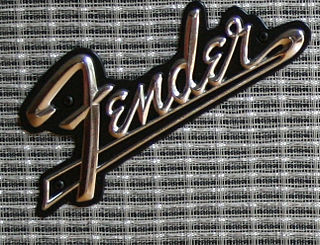 W
WLeo Fender began building guitar amplifiers before he started manufacturing electric guitars. The first of these were the K&F models, produced between 1945 and 1946. The early K&F and Fender amplifiers relied upon vacuum tube circuitry, with the company adding solid-state models in the late 1960s.
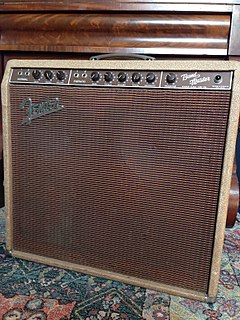 W
WThe Fender Bandmaster was a musical instrument amplifier made by Fender. It was introduced in 1953 and discontinued in 1974. Some early models had both a microphone input and instrument inputs. Beginning in 1960, Bandmaster amps were equipped with a vibrato effect. In the 2000s, vintage Bandmaster amps remain in use by blues, Americana and rock and roll bands.
 W
WThe Fender Bassman is a bass amplifier series introduced by Fender during 1952. Initially intended to amplify bass guitars, the 5B6 Bassman was used by musicians for other instrument amplification, including the electric guitar, harmonica, and pedal steel guitars. Besides being a popular and important amplifier in its own right, the Bassman also became the foundation on which Marshall and other companies built their high-gain tube amplifiers.
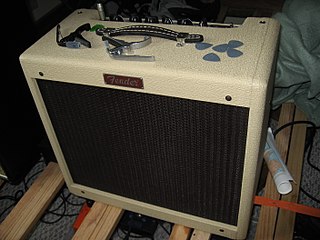 W
WThe Blues Junior is a tube guitar amplifier introduced in 1990 by the Fender Musical Instrument Corporation. It is aimed at achieving the warm, tube-driven tone common in many styles of American blues and blues rock dating back to the 1950s, while remaining both portable and affordable. Fender frequently releases limited editions of the Blues Junior. All have the same electronic components and specifications but have cosmetic changes and often a different speaker, at varying prices.
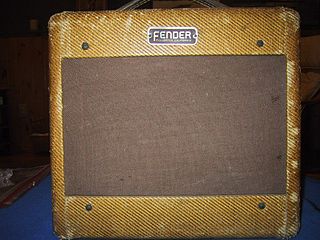 W
WThe Fender Champ was a guitar amplifier made by Fender. It was introduced in 1948 and discontinued in 1982. An updated version was introduced in 2006 as part of the "Vintage Modified" line.
 W
WThe Fender Harvard is a vacuum tube (valve) guitar amplifier made by Fender from 1955 to 1963. The Harvard appeared only in a tweed covered "narrow-panel" cabinet, but in two very different circuit designs, namely 5F10 (1955–61) and 6G10 (1962–63).
 W
WThe Fender Hot Rod Deluxe is a guitar amplifier manufactured and sold by the Fender Musical Instruments Corporation. It was introduced in 1996 as part of the "Hot Rod" line of guitar amplifiers and has been in continuous production since. The Hot Rod Deluxe is a modified version of the Fender Blues Deluxe from the earlier Blues line of amplifiers, and has a higher level of gain in its preamplification signal. This model, along with the Hot Rod Deville, were originally designated as F.A.T. amplifiers but this moniker was dropped in 2002 when production of this series of amps was moved from Corona, CA to Fender's Baja-Ensenada, Mexico manufacturing facility.
 W
WThe Fender Hot Rod DeVille is a combo tube guitar amplifier manufactured and sold by Fender. It was introduced in 1996 as part of Fender's Hot Rod line of amplifiers, and since then has been in continuous production. The Hot Rod DeVille is a modified version of the earlier Fender Blues DeVille from the Blues amplifier line, and has a higher level of gain in its preamplification signal. The DeVille incorporates a 60 watt amplifier, and is available in two different models: a 212, which includes a pair of Celestion A-Type 12" speakers, and the 410, which includes four 10" speakers. The DeVille is the sister amplifier of the Fender Hot Rod Deluxe.
 W
WThe Fender Princeton was a guitar amplifier made by Fender. It was introduced in 1947 and discontinued in 1979. After Fender introduced the Champ Amp in 1948, the Princeton occupied the next to the bottom spot in the Fender line. Fender Princetons from the early models into the 1970s models are highly valued particularly as recording amplifiers.
 W
WThe Fender Super Reverb is a guitar amplifier made by Fender. It was originally introduced in 1963 and was discontinued in 1982. The Super Reverb was a Fender Super amplifier with built-in reverb and "vibrato". The original Super Reverb amplifiers were all-tube designs and featured spring reverb. There were two different designs, distinguishable by the color of the "face" or front control panel. Super Reverbs from 1963 through 1967 had "blackface" panels. From 1968 until its discontinuation in 1982, the Super Reverb had "silverface" cosmetics and circuitry. Early models in 1968, while cosmetically "silverface", did contain "blackface" circuitry. Fender introduced a reissue '65 Super Reverb in 2001 featuring a printed circuit board design rather than the hand-wired circuitry of the original '65 Super Reverb.
 W
WThe Fender Twin and Twin Reverb are guitar amplifiers made by Fender Musical Instruments Corporation. The Twin was introduced in 1952, two years before Fender began selling Stratocaster electric guitars. The amps are known for their characteristically clean tone.
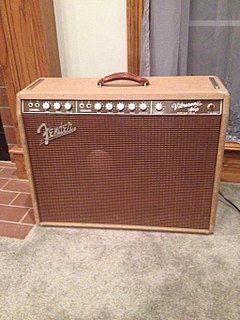 W
WThe Fender Vibrasonic was an amplifier made by Fender. It was debuted as the first of the new-model Fender amps of the 1960s, with new tolex-covered cabinets and front-mounted control panels that would replace the tweed-covered, top-panel cabinets that were prevalent during the 1950s, as well as new circuitry which would characterize most Fender amplifiers for two decades.
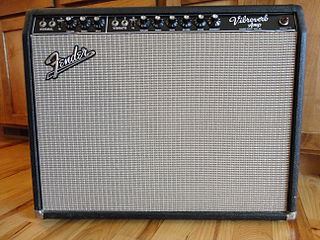 W
WThe Fender Vibroverb was a 40-watt combo guitar amplifier originally manufactured in 1963 and 1964. It was the first Fender amplifier to incorporate on-board reverb which became a standard feature on many high-end Fender tube amps during the 1960s and 1970s.
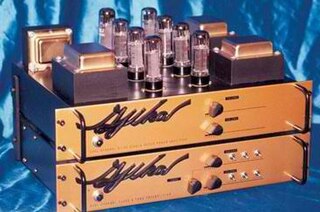 W
WGjika Amplification was founded in Boston, Massachusetts in the early 1980s, by Robert (Bob) Gjika. Gjika amplifiers are original designs, and are completely hand-wired.
 W
WA guitar amplifier is an electronic device or system that strengthens the weak electrical signal from a pickup on an electric guitar, bass guitar, or acoustic guitar so that it can produce sound through one or more loudspeakers, which are typically housed in a wooden cabinet. A guitar amplifier may be a standalone wood or metal cabinet that contains only the power amplifier circuits, requiring the use of a separate speaker cabinet–or it may be a "combo" amplifier, which contains both the amplifier and one or more speakers in a wooden cabinet. There is a wide range of sizes and power ratings for guitar amplifiers, from small, lightweight "practice amplifiers" with a single 6" speaker and a 10 watt amp to heavy combo amps with four 10” or four 12" speakers and a powerful 100 watt amplifier, which are loud enough to use in a nightclub or bar performance.
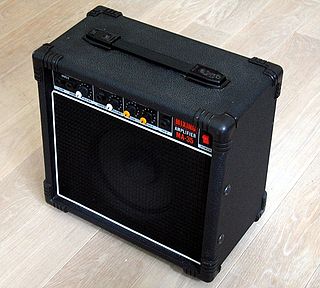 W
WA keyboard amplifier is a powered electronic amplifier and loudspeaker in a wooden speaker cabinet used for amplification of electronic keyboard instruments. Keyboard amplifiers are distinct from other types of amplification systems such as guitar amplifiers due to the particular challenges associated with making keyboards sound louder on stage; namely, to provide solid low-frequency sound reproduction for the deep basslines which keyboards can play and crisp high-frequency sound for the high-register notes. Another difference between keyboard amplifiers and guitar/bass amplifiers is that keyboard amps are usually designed with a relatively flat frequency response and low distortion. In contrast, many guitar and bass amp designers purposely make their amplifiers modify the frequency response, typically to "roll off" very high frequencies, and most rock and blues guitar amps, and since the 1980s and 1990s, even many bass amps are designed to add distortion or overdrive to the instrument tone.
 W
WThe Leslie speaker is a combined amplifier and loudspeaker that projects the signal from an electric or electronic instrument and modifies the sound by rotating a baffle chamber ("drum") in front of the loudspeakers. A similar effect is provided by a rotating system of horns in front of the treble driver. It is most commonly associated with the Hammond organ, though it was later used for the electric guitar and other instruments. A typical Leslie speaker contains an amplifier, a treble horn and a bass speaker—though specific components depend upon the model. A musician controls the Leslie speaker by either an external switch or pedal that alternates between a slow and fast speed setting, known as "chorale" and "tremolo".
 W
WThe Marshall JTM45 is the first guitar amplifier made by Marshall. First produced in 1963, it has been called a "seminal" amplifier, and is praised as the most desirable of all the company's amplifiers.
 W
WThe Marshall Major was a guitar amplifier made by Marshall. It was introduced in 1967 as the "Marshall 200". It had a plexi panel and two inputs in one channel, but in contrast with the 100 watt heads made by Marshall, the first series had split tone controls similar to the Sound City amps. For the second series, in late 1968, Marshall reverted to ordinary passive tone controls, and was called "Marshall Major". Some authors claim the first version had active tone controls but this is incorrect, the schematics for all versions are available online.
 W
WThe Mesa Boogie Mark Series is a series of guitar amplifier made by Mesa Engineering. Originally just referred to as "Boogies," the product line took on the moniker "Mark Series" as newer revisions were put into production. The Mark Series amplifier was Mesa's flagship product until the introduction of the Rectifier series, and the amplifiers are collectable.
 W
WThe Peavey Bandit 112 is a guitar amplifier produced by Peavey Electronics. It is a solid state amplifier designed for Jazz, Blues, Rock and Heavy metal musicians.
 W
WThe Peavey Classic 30 112 is a guitar amplifier produced by Peavey Electronics. It is a tube amplifier designed for Blues, Country and Rock musicians. The Classic 30 112 is a member of the Classic Series family of amplifiers. The amps are known for their durability, flexibility, and tone. Earlier models were dressed in black tolex, while more recent models are dressed in a diagonal tweed material.
 W
WThe Peavey Delta Blues 115 is a guitar amplifier produced by Peavey Electronics. It is a tube amplifier designed for Blues musicians. The name is inspired by the Delta blues, an early style of blues music that originated in the Mississippi Delta. The 15 inch speaker is part of its distinctive mid-range and low end sound. It is complemented by the Delta Blues 210 in the Peavey lineup. The Peavey Delta Blues 115 is comparable to the Fender '65 Twin Custom 15, along with other amplifiers. The Delta Blues 115 is a member of the Classic Series family of amplifiers, and is very similar to its sister amp the Peavey Classic 30, aside from some different features.
 W
WThe Rockman is a headphone guitar amplifier. The original Rockman was developed and built by Scholz Research & Development, Inc., a company founded by Tom Scholz, who is also the founder and a key member of the rock band Boston. Scholz Research & Development was sold to Dunlop Manufacturing, Inc. in 1995. Dunlop continues to manufacture the Rockman Ace, and Tom Scholz's signature still appears on the unit.
 W
WThe Roland Bolt 30/60/100 was the only line of tube guitar amplifiers produced by Roland. The amplifier was launched in the market in 1979 when the Roland company was trying to pursue the success of the Mesa Boogie Mark amplifiers.
 W
WRoland Jazz Chorus is the name given to a series of solid-state instrument amplifiers produced by the Roland Corporation in Japan since 1975. Its name comes from its built-in analog chorus effect. The Jazz Chorus series became increasingly popular in the late 1970s and early 1980s new wave and post-punk scenes because of its clean yet powerful sound, durability and relatively low cost when compared to the more commonly used tube amplifiers of the time such as Marshall or Fender. It also found favour amongst funk players in America. It also became popular to use for clean tones in heavy metal, with the most famous users being James Hetfield and Kirk Hammett from Metallica, and Wes Borland from Limp Bizkit.
 W
WA treble booster is an effects unit used by guitarists to boost volume and especially the high end of their tonal spectrum, and was popular mostly during the 1960s.
 W
WVintage musical equipment is older music gear, including instruments, amplifiers and speakers, sound recording equipment and effects pedals, sought after, maintained and used by record producers, audio engineers and musicians who are interested in historical music genres. While any piece of equipment of sufficient age can be considered vintage, in the 2010s the term is typically applied to instruments and gear from the 1970s and earlier. Guitars, amps, pedals, electric keyboards, sound recording equipment from the 1950s to 1970s are particularly sought. Musical equipment from the 1940s and prior eras is often expensive, and sought out mainly by museums or collectors.
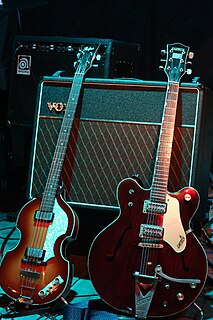 W
WThe Vox AC30 is a guitar amplifier manufactured by Vox. It was introduced in 1958 to meet the growing demand for louder amplifiers. Characterised by its "jangly" high-end sound it has become widely recognized by British musicians and others.